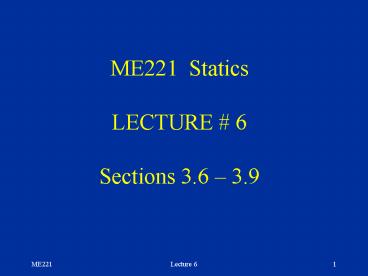ME 221 Statics - PowerPoint PPT Presentation
Title:
ME 221 Statics
Description:
... problems Exam 1 Pitfalls Vectors have both magnitude and direction Exam 1 Topics All of Chapters 1 & 2 except 2.11 ... June 2 No class ... Scalars & vectors ... – PowerPoint PPT presentation
Number of Views:101
Avg rating:3.0/5.0
Title: ME 221 Statics
1
ME221 StaticsLECTURE 6Sections 3.6 3.9
2
Homework 2
- Due today
Quiz 3
- Today
3
Homework 3
- Chapter 3 problems
- 48, 55, 57, 61, 62, 65 72
- Chapter 4 problems
- 2, 4, 10, 11, 18, 24, 39 43
- Due Monday, June 7
4
Moment of a Couple
F1
d
rABrB/A
F2
rB
rA
The Moment of two equal and opposite forces is
called a Couple
CF1 d
5
Moment of a Couple (continued)
- The two equal and opposite forces form a couple
(no net force, pure moment)
- The moment depends only on the relative
positions of the two forces and not on their
position with respect to the origin of coordinates
6
Moment of a Couple (continued)
- Since the moment is independent of the origin,
it can be treated as a free vector, meaning that
it is the same at any point in space
- The two parallel forces define a plane, and the
moment of the couple is perpendicular to that
plane
7
Equivalent Force Systems
- Replacing a given set of forces with an
equivalent force-moment system
8
Equivalent Force Systems
The action of a force tends to translate the body
along the direction of the force and rotate it
about an axis not located along the line of
action of the force. The External Effects remain
the same if the force is moved from one point to
another (from A to B ) if
9
1- Point B is on the line of action of the force
A force can be replaced by an equal magnitude
force provided it has the same line of action and
does not disturb equilibrium
10
2- Point B is not on the line of action of the
force
- Start with a rigid body having force F applied to
it.
Replace this force with a force and couple at A.
Add zero to the body in the form of adding F
and -F
11
- Next, group two forces to create couple C
Define couple with cross product C rB/A x F
In essence, the force F has been moved from point
B to A with the addition of couple C.
12
For More Than One Force
- A similar procedure is used when there are many
forces on the body
R S Fi C S ci S ri x Fi
13
Example Problems
14
ME 221 StaticsExam 1 Review
15
Exam 1
- Wednesday, June 2
- No class on Monday, May 31
16
Exam Format
- Similar to homework problems
- 5 or 6 (maybe 7) problems
- No new concepts
- Closed books and closed notes
- 25 of final grade
- Will need a calculator
17
Exam 1 Helpful Hints
- Study by working homework problems
- Review the examples in the book
- Read the exam questions carefully
- Work the problems you know first
- Use a logical flow to show your knowledge
- Be complete check your answers
18
Exam 1 Pitfalls
- Vectors have both magnitude and direction
- Most answers will have units
- Calculated answers should be in decimal form
- Use 3 significant figures where appropriate
- Answers are generally worth 1/3 of points
- Steps leading to answers are worth 2/3
19
Exam 1 Topics
- All of Chapters 1 2 except 2.11 Springs
- Up to 3.4 in Chapter 3
- Newtons Laws
- Units
- Scalars vectors defining, adding, etc.
- Laws of sine and cosine
- Resolution of a vector into components
20
Exam 1 Topics
- 3D coordinates unit base vectors
- Directional cosines
- Non-orthogonal vector components
- Scalar cross products of vectors
- 2D 3D equilibrium problems
- Moments couples
- Drawing good free-body diagrams































